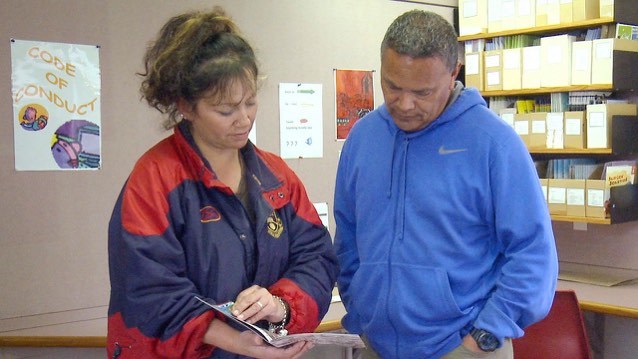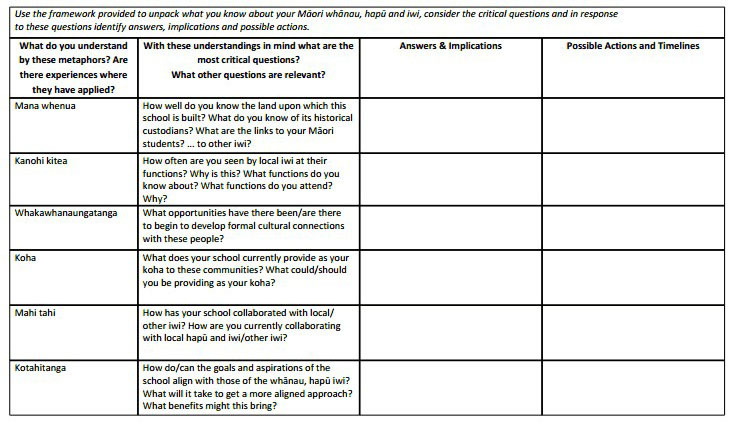9
Key messages from the Family and Community Engagement BES
Successful home-school partnerships are characterised by:
- families being treated with dignity and respect;
- programmes adding to family practices – getting an insight into our boys, not undermining them;
- structured, specific suggestions and ongoing support rather than general advice; and
- supportive group opportunities as well as one-to-one contact (especially informal contact).
Consider how these four points relate to the Māori metaphors used in the making metaphors meaningful discussion that follows.

Making Metaphors Meaningful
[Download 1]
Metaphors assist us to consider and reflect upon our understandings (theorising) and subsequent actions (practice). We have incorporated into this module some Māori metaphors to provide a framework for you to consider how you work in partnership and collaborate with your Māori whānau and community.
We explain each of these metaphors briefly below. However, members of your staff are probably well able to provide examples and more detail.
What do you understand by these metaphors?
Taonga Tuku Iho
From a Māori worldview, taonga tuku iho literally mean the collective treasures of our ancestors. In a metaphoric sense they refer to the accumulated knowledge and cultural aspirations Māori have for themselves and for their future generations (Smith, 1997).
Within these treasures or aspirations are the very kawa or epistemologically-based principles and pre-determined patterns of relationships and interactions that have both guided the way we do things and monitored the actions of research-whānau members.
Within taonga
10
Mana whenua
From one iwi to the next, the mana whenua are recognised as guardians of the land. From a Māori perspective, their worldly power and prestige as guardians and holders of the land must continue to be acknowledged and respected. When this happens, the active participation and commitment of the mana whenua or local people, to different groups occupying these lands, can develop a reciprocal relationship of support and strength.
Kanohi kitea
The whakataukī, he kanohi kitea (the seen face), suggests the importance of being seen and known to the participants in their own cultural settings, rather than only in school settings.
Whakawhanaungatanga
Whakawhanaungatanga is the process of establishing links, making connections and relating to the people one meets by identifying in culturally appropriate ways, whakapapa linkages, past heritages, points of engagement, or other relationships.
Establishing whānau connections is kinship in its widest sense. Whakawhanaungatanga reinforces the commitment that members of a whānau have to each other while also reminding them of their responsibilities and obligations to all (Berryman et al., 2002).
In a metaphoric sense, Mead (2003) asserts that whanaungatanga reaches beyond actual whakapapa relationships and includes relationships to people who are not kin but who, through shared experiences, feel and act as kin. Within this type of metaphoric whānau relationship, while one may receive support from the collective, be it whānau or otherwise, there is a responsibility to contribute your support in return.
Koha
Koha is the cultural act of repaying obligation or contributing by gifting (koha). Traditionally koha came in the form of food and other resources, today koha are more likely to come in the form of money. While there is no obligation to provide koha, there is also no obligation to accept koha. Bishop (1996) identifies koha as an appropriate metaphor to describe the research relationship.
It describes the offering of the research project as a maioha (gift) to the participant/s such that it is their choice to accept it or not.
Cram (2001) suggests that if they decide to enter into a relationship then the relationship will be seen as ongoing with “no boundaries or time constraints” (p.43).
11
Mahi tahi
Mahi tahi is a term used to describe the unity of people working towards a specific goal or the implementation of a task often in a ‘hands-on’ fashion. Whereas kotahitanga is the state of being united, mahi tahi is the act of carrying out the task or activity for which you have come together in a common purpose.
The solidarity that mahi tahi engenders in a group of people is powerful and this kind of relationship is known to sustain itself well after the goal has been fulfilled or the project has been completed (Berryman et al., 2002). The philosophy of mahi tahi comes from traditional times.
Working together was vital for activities such as construction, food production, child rearing and warfare.
Kotahitanga
As a collective, any group has the potential to pursue their own goals. Each individual has a role to play, each person works towards achieving the common goal, thus when all individuals unite under the same objective it is more likely to be attainable.


